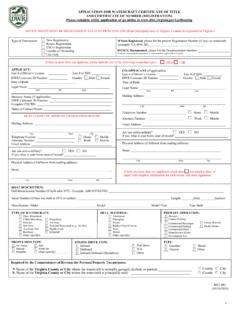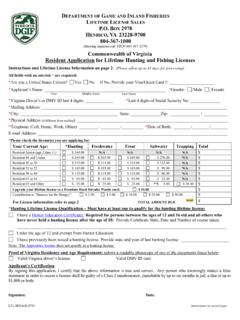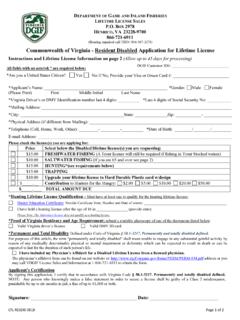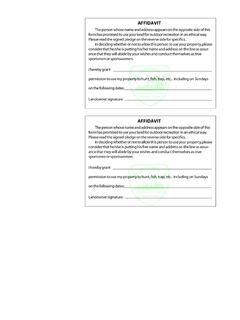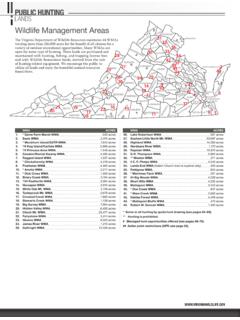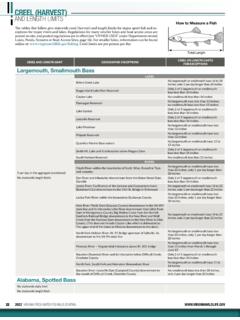Transcription of Deer Hunting with Dogs - Virginia Department of Wildlife ...
1 Department OF GAME AND INLAND. FISHERIES. A REPORT ON. DEER Hunting WITH DOGS. January 2016. 1. Introduction On October 15, 2015, the Board of Game and Inland Fisheries requested a report for the January 2016 Board meeting on issues surrounding deer Hunting with dogs, potential options to address any issues, and a recommended approach going forward. This request followed input provided by several members of the Virginia Landowners Association who attended the October 15. meeting. This report does not recommend any regulatory or legislative actions. The Virginia Deer Management Plan directs VDGIF to preserve the heritage and tradition of Hunting deer (including with dogs), for both management and recreational benefits, while ensuring that Hunting methods are consistent with and respect the rights of private property owners and other citizens (VDGIF 2015).
2 Deer Hunting with dogs is an important tradition and deer population management tool in eastern Virginia , but it can generate concerns from other hunters and landowners regarding trespassing dogs, trespassing hunters, and Hunting from or near roads (VDGIF 2015). This report borrows heavily from work done by VDGIF and Virginia Tech during the 2007-2009. Hunting with Hounds in Virginia : A Way Forward process. Products from the process included a 121-page peer-reviewed technical report written by Department staff (VDGIF 2008a), survey and written comment summaries by Virginia Tech (Kozlowski et al. 2008, McMullin et al.)
3 2008), and recommendations by a Stakeholder Advisory Committee. As of 2015, no regulatory or statutory changes have been made as a result of this process. Description of the Issues Deer may be hunted with dogs east of the dog line (Figure 1). The most recent data available indicated that 29% (approximately 55,000) of deer hunters in Virginia used dogs at least once during the season (VDGIF 2008b); 44% of deer hunters used dogs in regions of Virginia where dogs may be used to hunt deer (VDGIF 2005). In the Tidewater region, 73% of deer hunters used dogs (VDGIF 2005) and accounted for 86% of all deer harvested regionally during the general season (VDGIF 2006; unpublished harvest data).
4 In the Southern Piedmont, approximately half of the deer harvested during the general season were taken by hunters who used hounds (VDGIF 2006; unpublished harvest data). It is not known how many of these hunters used dogs exclusively. Deer Hunting with dogs allowed. Rappahannock Culpeper Deer Hunting with dogs prohibited Madison Stafford Greene King George Orange Spotsylvania Westmoreland Albemarle Essex Richmond Northumberland Essex Nelson Fluvanna Alleghany Hanover Goochland King and Queen King William Lancaster King William C. Amherst Middlesex u Buckingham m Powhatan Powhatan Powhatan b Henrico New New Kent Kent er Gloucester Mathews la Chesterfield Appomattox Amelia Charles City n Prince Edward Campbell Nottoway Prince George Surry Dinwiddie Charlotte Lunenburg Sussex Isle of Wight Halifax Virginia Brunswick Beach Mecklenburg Southampton Chesapeake Greensville Deer Dog line.
5 Figure 1. Areas open and closed to deer dog- Hunting in Virginia , demarcated by the dog line.. 2. The economic impact attributable directly to deer Hunting with hounds is unknown. However, the pursuit of this sport involves purchasing special equipment, in addition to purchasing and maintaining Hunting hounds. An informal survey by Virginia Hunting Dog Alliance estimated that each member of deer-dog hunt clubs in the southern Piedmont spent an average of $3,000 a year for fuel, dog care, equipment, and other Hunting -related expenses (VDGIF 2008a). Due to the distances covered during deer chases, high visibility, and frequent interactions with landowners and other outdoor users, deer Hunting with dogs can be controversial at times.
6 The Department receives complaints from residents and other hunters about trespass, violation of privacy, and interference from deer hunters who use dogs. Changing land uses, demographics, and societal attitudes are exerting pressures on the sport not seen a generation ago. Under the pretext of other legal pursuits, some deer hunters who use dogs may engage in activities that lead to conflicts with other citizens or that are viewed as objectionable by the public (VDGIF 2008a). For example, some hunters may chase game or disturb other citizens on prohibited lands under the guise of retrieving Hunting dogs (Code of Virginia ), chase deer out-of-season during year-round fox chase seasons (Code of Virginia ), or road- hunt under laws or ordinances which vary considerably by locality.
7 A number of states permit retrieval of Hunting dogs without landowner permission under certain conditions ( , on unposted properties), but Virginia appears to be one of only two states where hunters can lawfully retrieve dogs even when access has been expressly denied by the landowner. In Minnesota, the other state with a similar dog-retrieval law, dogs cannot be used to hunt deer. Deer chase characteristics, land use and demographic trends, hunter opinions, public comments, documented dog-related complaints made to VDGIF, and similar experiences in other states provide context for these issues. Characteristics of deer chases.
8 Deer Hunting with dogs typically requires large tracts of land due to the extent of the chase. In studies of unconstrained, traditional hunts conducted in 5. southeastern states, the average deer chase lasted 11-33 minutes and extended miles (VDGIF 2008a). Historically, hound-hunts for deer took place on farms with contiguous areas in excess of 20,000 acres. Today, most deer clubs have access, through ownership, leases, or informal agreements, to areas 1,000-5,000 acres in size, much of which is fragmented. In 2008, Virginia Deer Management Assistance Program (DMAP) properties east of the Blue Ridge Mountains where hounds were used averaged 3,400 acres, while still-hunt only properties averaged 1,300 acres (VDGIF 2008a).
9 Land use and demographic changes. Growing at a rate of each year since 1960, the estimated population in Virginia now exceeds 8 million people. The growth in human populations has not been uniform across the state, and some high-growth urban and suburban areas are open to deer Hunting with dogs ( , Richmond, Hampton Roads). Byproducts of human population growth that impact deer Hunting have been changes in land use, parcel size, and cultural norms. Land development fragments and reduces the land base available for Hunting , intensifying competition among land uses and activities on remaining undeveloped lands (VDGIF 2008a).
10 3. Between 1959 and 2012 in Virginia , the total farmland acreage and the total number of farms have decreased by 36% and 54%, respectively. In 1959, 52% of Virginia 's land area was in farmland compared to only 33% in 2012. Land ownership patterns of forested habitats have also changed over recent decades. In 1992. timber companies owned 11% of the forested land area in Virginia , but by 2012 they only owned approximately 1% (VDOF 2014). Most of Virginia 's forestland (76%) is privately owned as nonindustrial private forest land (NIPF), but the NIPF component is even greater (>80%) in dog Hunting areas of the southern Piedmont and Coastal Plain (Rose 2007).
